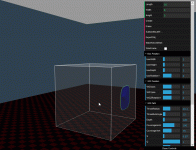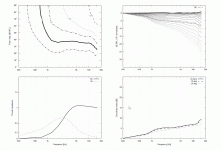Yeah. There are many ways to look at this in BabylonJS. I can fill the waveguide space with 100 million GPU particles and then apply a pink noise vibration to the mouth. Quick example of a block moving through through a point cloud. Gives you an idea of where I'm heading.What, ripple tank in 3D?😀 Nice!
https://playground.babylonjs.com/#UI95UC#21
I'll start a new thread I think. The app is quite mature now.
I remember you mentioning this but I've never understood what it's supposed to show. So maybe I will finally get it 🙂
While the sims probably take some time not to have it exactly real time this kind of thing should be possible on browser. Both desmos and matlab/octave have API. I have no idea how much work it would be 😀 probably at least few evenings worth + expensive server to get performance up, or use localhost.Fascinating. If one now could see in real time the effect of the sliders in your standard report (e.g. 39-48.png above) it would be a fun excersie 🙂
//
I think maiky76 reported 80ms per iteration, which would be almost real-time. But of course the limitation at the moment is the half-space (infinite baffle) nature of the MMM_toolbox. Still quite amazing, if done.
I was mostly waiting for BabylonJS to move to WebGPU support. It took a few nights and beers to get my head around coding again!I remember you mentioning this but I've never understood what it's supposed to do. So maybe I will finally get it 🙂
Last edited:
This is just beautiful!Baffle mode - https://www.desmos.com/calculator/y47st9skiq
(There will be a step change in curvature where the WG connects the baffle. The OSSE formula is better in this regard.)
View attachment 1018585
Is there a way to export points on the final curve so one could draw a spline in a CAD of choice?
We have a similar (perhaps better) curve since 2019 -
https://www.desmos.com/calculator/ggzoijr0pg
I don't know how to export from Desmos. But in some CAD packages there's an option to define the formula directly.
Ath allows to import this as a spline into Fusion 360. From there it can be saved as DXF.
https://www.desmos.com/calculator/ggzoijr0pg
I don't know how to export from Desmos. But in some CAD packages there's an option to define the formula directly.
Ath allows to import this as a spline into Fusion 360. From there it can be saved as DXF.
I've envisioned this too and am trying (struggling) with MMM in python/cupy to run stuff on the gpu. My CPU is not that powerful and parallel (optimization) does not work (at least out of the box) in Octave.Fascinating. If one now could see in real time the effect of the sliders in your standard report (e.g. 39-48.png above) it would be a fun excersie 🙂
//
Remember that in your case it's an infinite baffle simulation and that the DI will be higher towards low frequencies when placed in an enclosure. If there's a midrange narrowing in an infinite baffle, it probably will get worse in a finite baffle. So I wouldn't try for the flatter DI.
That's one of the reasons I like free-standing horns - one can easily simulate and optimize the real free-space performance without the need to model an enclosure. Besides that they work like a charm.
That's one of the reasons I like free-standing horns - one can easily simulate and optimize the real free-space performance without the need to model an enclosure. Besides that they work like a charm.
Last edited:
Is it possible to have this sort of optimization happen with a baffled device, maybe even a box with roundovers?Tweaking GCurve.Dist = 0.39 / 0.41 / 0.43 (animated gif)
I still have the problem with a waveguide I had been simulating for many hours. Recently, fluid was so kind and made the effort to do a limited simulation in a baffle with ABEC. I needed to see how the performance changes on on a baffle. Drastically so. This showed to me that it is rather useless to optimize a baffled waveguide without regard to the diffraction effects generated by the box itself. Its impacts are too severe. Is it possible to do it with your new "API"?
edit: mabats cross post underscores the demand for such a solution
The solution is simple - go free standing.
It was before I switched to free standing that I planned to implement an enclosure model into Ath. Frankly, I don't see the point any more.
It was before I switched to free standing that I planned to implement an enclosure model into Ath. Frankly, I don't see the point any more.
That is too bad, because I am not interested in a free standing device.The solution is simple - go free standing.
It was before I switched to free standing that I planned to implement an enclosure model into Ath. Frankly, I don't see the point any more.
Maybe someone else will implement it some day.
I think that the jury is out on the free-standing vs. baffled. I think that they will likely be very close and that each will have some trade-offs. Unless there is measured evidence that I am not aware of.
- Home
- Loudspeakers
- Multi-Way
- Acoustic Horn Design – The Easy Way (Ath4)

